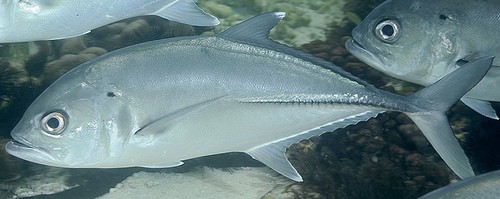Bigeye trevally
A species of Jacks, Also known as Great trevally, Dusky jack, Trevallies, Bigeye crevalle jack Scientific name : Caranx sexfasciatus Genus : Jacks
Bigeye trevally, A species of Jacks
Also known as:
Great trevally, Dusky jack, Trevallies, Bigeye crevalle jack
Botanical name: Caranx sexfasciatus
Genus: Jacks
Content
Description People often ask
 Photo By zsispeo , used under CC-BY-SA-2.0 /Cropped and compressed from original
Photo By zsispeo , used under CC-BY-SA-2.0 /Cropped and compressed from original Description
The bigeye trevally is one of the larger members of Caranx, growing to a maximum recorded size of 120 cm in length and 18.0 kg in weight. It is similar to most other jacks in having a compressed, oblong body, with the dorsal profile slightly more convex than the ventral profile, particularly anteriorly. The snout is slightly pointed, and is greater in length than the eye diameter. The dorsal fin is in two distinct sections; the first consisting of 8 spine and the second of 1 spine and 19 to 22 soft rays. The anal fin consists of 2 anteriorly detached spines followed by 1 spine and 14 to 17 soft rays. The pelvic fins consists of 1 spine and 17 to 18 soft rays, while the caudal fin is strongly forked and the pectoral fin falcate. The species lateral line is moderately arched anteriorly, with 49 to 50 scales in this section, while the straight section contains 0 to 3 scales and 27 to 36 strong scutes. The breast is completely covered in scales. The species has well-developed adipose eyelids, while its dentition consists of an outer row of widely spaced canine teeth and an inner band of villiform teeth in the upper jaw, with a row of widely spaced conical teeth on the lower jaw. The bigeye trevally has 21 to 25 gill rakers and 25 vertebrae. The bigeye trevally shows a change in colour as it ages, changing both overall colour and body patterns. Juveniles are a silvery yellow to silvery brown in colour, and possess five to six dark vertical bands on their sides, from which the specific epithet sexfasciatus arose. As they mature, the bands fade and become indistinct and the overall colour shifts to a silvery blue above and whitish below. In adults, the bars are completely absent and the dorsal colour is a silvery olive to blue green, fading to silvery white below. In juveniles, the fins are pale grey to yellow with darker edges, becoming darker overall in adulthood, with the anal and caudal fins yellow to black and the second dorsal fin olive to black. The tip of the second dorsal fin has a distinctive white tip. The bigeye trevally also has a small dark opercular spot on the upper margin.
* Disclaimer: The judgment on toxicity and danger is for reference only. We DO NOT GUARANTEE any accuracy of such judgment. Therefore, you SHALL NOT rely on such judgment. It is IMPORTANT TO SEEK PROFESSIONAL ADVICE in advance when necessary.
People often ask
How big does bigeye trevally get?
What color is bigeye trevally?
Scientific Classification
Phylum
Chordates Class
Fish Order
Perch-like fish Family
Trevallies Genus
Jacks Species
Bigeye trevally